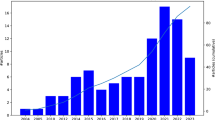Abstract
We consider the profit maximization problem in the calendar planning of investment projects taking into account reinvestment of the obtained revenue and the possibility of using credits. We construct the corresponding models and study their properties. Strong NP-hardness of the profit maximization problem is proved in the case when the amount of the credit is not limited.
Similar content being viewed by others
References
E. Kh. Gimadi, V. V. Zalyubovskii, and S. V. Sevastyanov, “Polynomial Solvability of Scheduling Problems with Storable Resources and Directive Deadlines,” Diskretn. Anal. Issled. Oper. Ser. 2, 7 (1), 9–34 (2000) [J. Appl. Indust. Math. 1 (4), 442–452 (2007)].
E. A. Kazakovtseva and V. V. Servakh, “Financing and Reliability Analysis for Schedules in the Project Calendar Planning Problem,” Avtomat. i Telemekh. No. 7, 87–98 (2014) [Automat. Remote Control 75 (7), 1231–1240 (2014)].
E. A. Kazakovtseva and V. V. Servakh, “NP-Hardness of the Project Scheduling Problem with Credits,” in Abstracts. XVI Baikal International School-Seminar “Optimization Methods and Their Applications,” Olkhon, Irkutsk Region, Russia, June 30–July 6, 2014 (Melentiev Energy Systems Inst., Irkutsk, 2014), p. 56.
E. A. Martynova and V. V. Servakh, “On Scheduling the Credited Projects,” Avtomat. i Telemekh. No. 3, 107–116 (2012) [Automat. Remote Control 73 (3), 508–516 (2012)].
E. A. Martynova and V. V. Servakh, “Optimizing the Use of Credits in the Project Scheduling Problem,” in Proceedings of the Russian Conference on Discrete Optimization and Operation Research, Novosibirsk, Russia, June 24–28, 2013 (Inst.Mat., Novosibirsk, 2013), p. 96.
V. V. Servakh and T. A. Shcherbinina, “Complexity of Some Project Scheduling Problem with Nonrenewable Resources,” Vestnik Novosib. Gos. Univ. Ser. Mat. Mekh. Inform. 8 (3), 105–112 (2008).
P. Brucker, A. Drexl, R. Möhring, K. Neumann, and E. Pesch, “Resource-Constrained Project Scheduling: Notation, Classification,Models, and Methods,” European J. Oper. Res. 112 (1), 3–41 (1999).
E. Kh. Gimadi and S. V. Sevastianov, “On Solvability of the Project Scheduling Problem with Accumulative Resources of an Arbitrary Sign,” in Operation Research Processing (Selected Papers of the International Conference onOperation Research, Klagenfurt, September 2–5, 2002) (Springer,Berlin, 2002), pp. 241–246.
R. H. Möhring, “Minimizing Costs of Resource Requirements in Project Networks Subject to a Fixed Completion Time,” Oper. Res. 32 (1), 89–120 (1984).
Project Scheduling: Recent Models, Algorithms, and Applications, Ed. by J. Weglarz (Kluwer Acad. Publ., New York, 1999).
A. H. Russell, “Cash Flows in Networks,” Management Sci. 16 (5), 357–373 (1970).
Author information
Authors and Affiliations
Corresponding authors
Additional information
Original Russian Text © E.A. Kazakovtseva, V.V. Servakh, 2015, published in Diskretnyi Analiz i Issledovanie Operatsii, 2015, Vol. 22, No. 4, pp. 35–47.
Rights and permissions
About this article
Cite this article
Kazakovtseva, E.A., Servakh, V.V. Complexity of the project scheduling problem with credits. J. Appl. Ind. Math. 9, 489–496 (2015). https://doi.org/10.1134/S1990478915040055
Received:
Accepted:
Published:
Issue Date:
DOI: https://doi.org/10.1134/S1990478915040055




